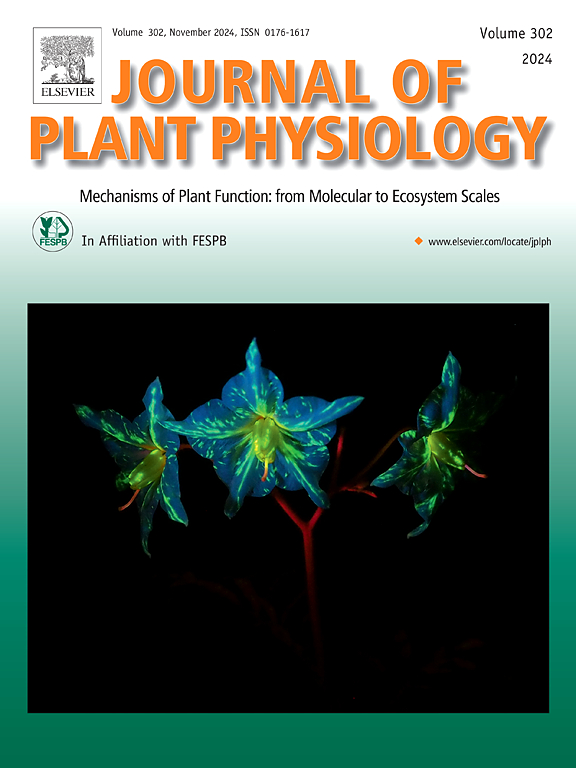揭示不同氮源和根际pH条件下质膜H+- atp酶在水稻植物适应缺磷中的作用
IF 4.1
3区 生物学
Q1 PLANT SCIENCES
引用次数: 0
摘要
土壤pH值对养分的生物利用度及其随后被植物根系吸收至关重要。对于氮和磷这两种对植物生长发育的各个方面都至关重要的关键常量营养素来说尤其如此。重要的是,一种营养物质的可用性可以影响另一种营养物质的获取和转运,尽管这一过程的机制基础仍未被探索。在这项工作中,我们结合了生理(生长;离子组学),分子(RNAseq和qPCR),生化(酶分析)和遗传(使用功能获得突变体)方法来研究磷有效性,两种形式的N供应(NO3−vs NH4+)和根际pH (3.0 vs 6.5)之间相互作用对水稻植株的影响。总的来说,在NH4+环境下生长的水稻植株比NO3−环境下生长的要好,在pH 6.5环境下比在pH 3环境下生长的好。在NH4+和NO3−处理下,缺磷显著降低了叶片氮积累量,但增加了根系氮积累量。转录组分析显示,在pH 6.5缺磷条件下,叶片中有8749个差异表达基因(DEGs),根系中有6519个差异表达基因(DEGs),这些基因与膜功能、细胞反应、代谢和细胞信号传导有关。NO3−和NH4+处理均能显著诱导deg质膜H+-ATPase基因表达,表明H+-ATPase可能在植物对P营养的适应性反应中起作用。后者在结合33P示踪剂的直接实验中得到证实。过表达编码H+- atp酶的OSA1可以改善水稻的营养吸收和生长。综上所述,这些结果表明,PM H+- atp酶在调节氮磷吸收中起着至关重要的作用,并为开发更有效地吸收和利用养分并从而能够实现最佳产量的作物品种提供了新的途径。本文章由计算机程序翻译,如有差异,请以英文原文为准。
Revealing the role of the plasma membrane H+-ATPase in plant adaptation to phosphorus deficiency in rice under various nitrogen sources and rhizosphere pH
Soil pH is critical for the bioavailability of nutrients and their consequent uptake by plant roots. This is specifically true for N and P, two key macronutrients that are essential for all aspects of plant growth and development. Importantly, availability of one nutrient can affect acquisition and translocation of another, although the mechanistic basis of this process remains unexplored. In this work, we combined a physiological (growth; ionomics), molecular (RNAseq and qPCR), biochemical (enzymatic assays) and genetic (using gain-of-function mutants) approaches to investigate the effect of interplay between P availability, two forms of N supply (NO3− vs NH4+) and rhizosphere pH (3.0 vs 6.5) on rice plants. In general, rice plants grown in the presence of NH4+ performed better than those treated with NO3− and better at pH 6.5 than at pH 3. P deprivation significantly reduced N accumulation in leaves but increased N in roots under both NH4+ and NO3− treatments. Transcriptome analysis revealed 8749 differently expressed genes (DEGs) in leaves and 6519 DEGs in roots under P deprivation at pH 6.5, related to membrane function, cellular response, metabolism, and cell signaling. Among the DEGs, the plasma membrane H+-ATPase genes were significantly induced by both P deprivation under NO3− and NH4+ treatments, indicating a possible role of H+-ATPase in plant adaptive responses to P nutrition. The latter was confirmed in direct experiments combining 33P radiotracers. Overexpression of OSA1 encoding a H+-ATPase improved nutrient uptake and rice growth. Overall, these results suggest that PM H+-ATPase plays a crucial role in the regulation of N and P uptake and provide a new approach to develop crop varieties that are more efficient at absorbing and utilizing nutrients and, hence, capable to achieve optimal yields.
求助全文
通过发布文献求助,成功后即可免费获取论文全文。
去求助
来源期刊

Journal of plant physiology
生物-植物科学
CiteScore
7.20
自引率
4.70%
发文量
196
审稿时长
32 days
期刊介绍:
The Journal of Plant Physiology is a broad-spectrum journal that welcomes high-quality submissions in all major areas of plant physiology, including plant biochemistry, functional biotechnology, computational and synthetic plant biology, growth and development, photosynthesis and respiration, transport and translocation, plant-microbe interactions, biotic and abiotic stress. Studies are welcome at all levels of integration ranging from molecules and cells to organisms and their environments and are expected to use state-of-the-art methodologies. Pure gene expression studies are not within the focus of our journal. To be considered for publication, papers must significantly contribute to the mechanistic understanding of physiological processes, and not be merely descriptive, or confirmatory of previous results. We encourage the submission of papers that explore the physiology of non-model as well as accepted model species and those that bridge basic and applied research. For instance, studies on agricultural plants that show new physiological mechanisms to improve agricultural efficiency are welcome. Studies performed under uncontrolled situations (e.g. field conditions) not providing mechanistic insight will not be considered for publication.
The Journal of Plant Physiology publishes several types of articles: Original Research Articles, Reviews, Perspectives Articles, and Short Communications. Reviews and Perspectives will be solicited by the Editors; unsolicited reviews are also welcome but only from authors with a strong track record in the field of the review. Original research papers comprise the majority of published contributions.
 求助内容:
求助内容: 应助结果提醒方式:
应助结果提醒方式:


